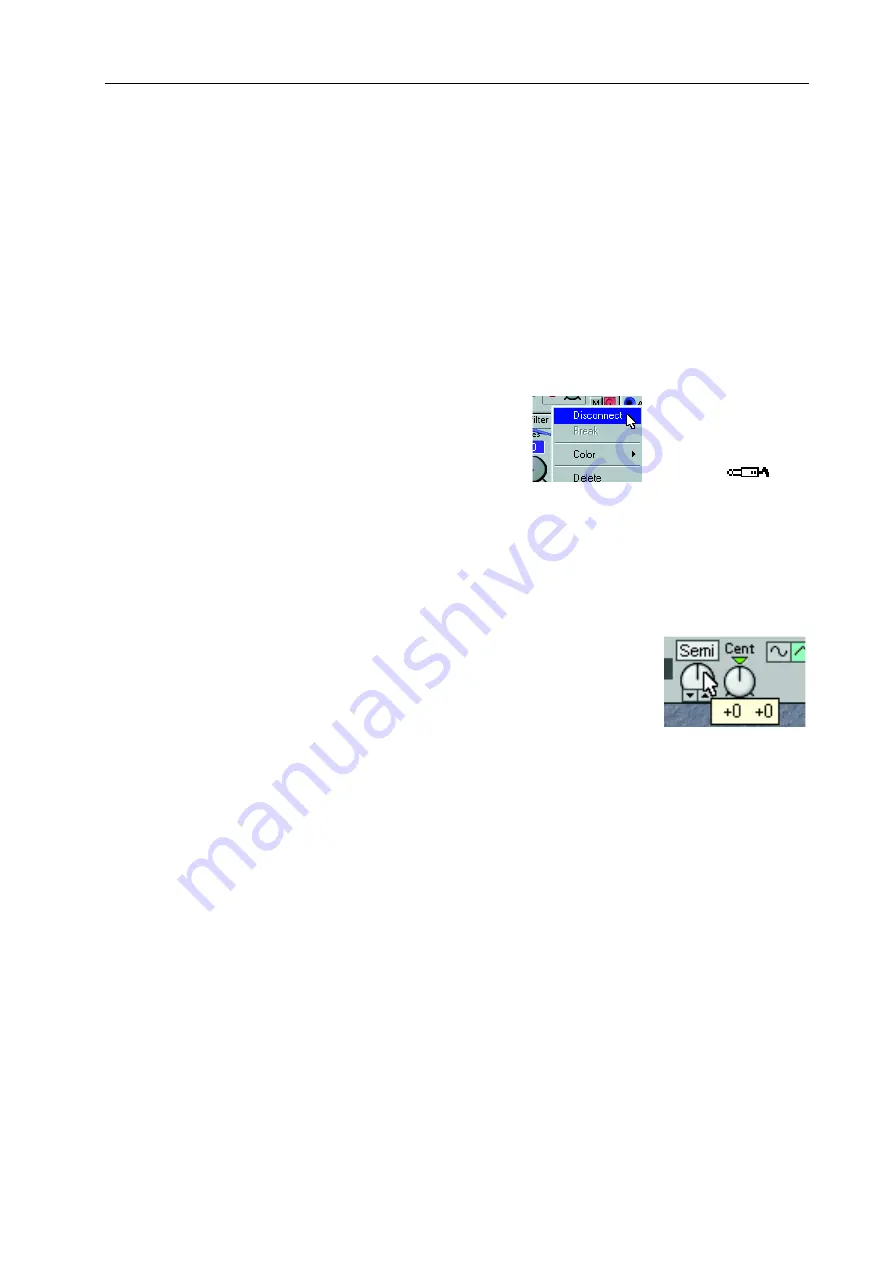
NORD MODULAR G2 V1.1
6. Patches: Patches (in-depth)
Page 43
It is also possible to make a serial connection between several inputs, without connecting to an output.
This won’t result in any signal flow, but can be useful if you want to choose an output after having con-
nected all inputs. These “non-functional” input-to-input connections are indicated by white cable color.
When you connect such a chain to an output, the cable color will change to the output’s color. It is also
possible to combine parallel and serial connections in several ways. For example, you could have a serial
connection branch off to a parallel connection anywhere in the chain.
H
H
H
H
IIIIG
G
G
GH
H
H
HL
L
L
LIIIIG
G
G
GH
H
H
HT
T
T
T
C
C
C
CA
A
A
AB
B
B
BL
L
L
LE
E
E
ES
S
S
S
A
A
A
AN
N
N
ND
D
D
D
C
C
C
CA
A
A
AB
B
B
BL
L
L
LE
E
E
E
C
C
C
CH
H
H
HA
A
A
AIIIIN
N
N
NS
S
S
S
To make it easy to follow cable connections and signal paths visually in the Patch, click-holding a con-
nector will highlight any connected cables or cable chains. The highlighted cable(s) turns light blue for
as long as you hold the mouse button depressed.
D
D
D
D
IIIIS
S
S
SC
C
C
CO
O
O
ON
N
N
NN
N
N
NE
E
E
EC
C
C
CT
T
T
T
O
O
O
OR
R
R
R
R
R
R
RE
E
E
E
----
R
R
R
RO
O
O
OU
U
U
UT
T
T
TE
E
E
E
C
C
C
CA
A
A
AB
B
B
BL
L
L
LE
E
E
ES
S
S
S
IIIIN
N
N
N
A
A
A
A
P
P
P
P
A
A
A
AT
T
T
TC
C
C
CH
H
H
H
To remove a cable, right-click on a connection (input or
output) and select Disconnect, or double-click-hold or
Ctrl-click on a connection (an extra wire appears next to the
connector cursor) and “pull out” the connector by dragging
the connector symbol away from the input/output and re-
lease the mouse button. If you place the “disconnected”
plug on another connection instead, the cable will be re-
routed.
E
E
E
E
D
D
D
DIIIIT
T
T
T
M
M
M
MO
O
O
OD
D
D
DU
U
U
UL
L
L
LE
E
E
E
P
P
P
PA
A
A
AR
R
R
RA
A
A
AM
M
M
ME
E
E
ET
T
T
TE
E
E
ER
R
R
RS
S
S
S
IIIIN
N
N
N
A
A
A
A
P
P
P
P
A
A
A
AT
T
T
TC
C
C
CH
H
H
H
P
P
P
P
U
U
U
UT
T
T
T
A
A
A
A
M
M
M
MO
O
O
OD
D
D
DU
U
U
UL
L
L
LE
E
E
E
P
P
P
PA
A
A
AR
R
R
RA
A
A
AM
M
M
ME
E
E
ET
T
T
TE
E
E
ER
R
R
R
“
“
“
“
IIIIN
N
N
N
F
F
F
F
O
O
O
OC
C
C
CU
U
U
US
S
S
S
”
”
”
”
A parameter can be a knob, slider or a selector switch (button). Put a parameter
“in focus” by clicking on it. An increment and decrement button appears below
the knob or slider parameter as you move the cursor over it, and the current set-
ting of the parameter displays briefly in a yellow hintbox. When you click on the
parameter, the increment/decrement buttons (or button selectors) are highlight-
ed.
To move the focus to another parameter in the module, press the Left/Right arrow buttons on the com-
puter keyboard.
To move the focus to another module in the Patch, press the Shift key on the computer keyboard together
with the Up/Down/Left/Right arrow buttons. The modules in a Patch are accessed depending on how
they were visually placed in the Patch window.
right-click
OR
Double-click/
Ctrl-click






























